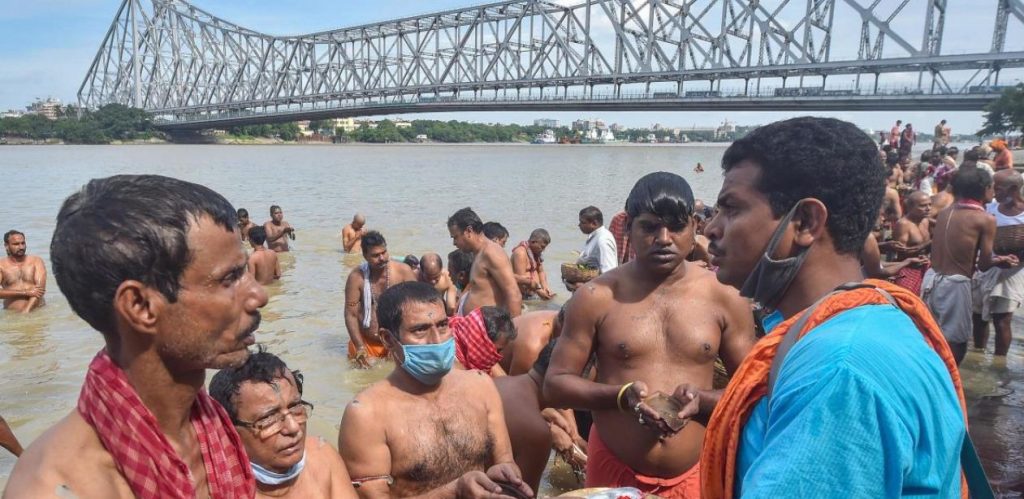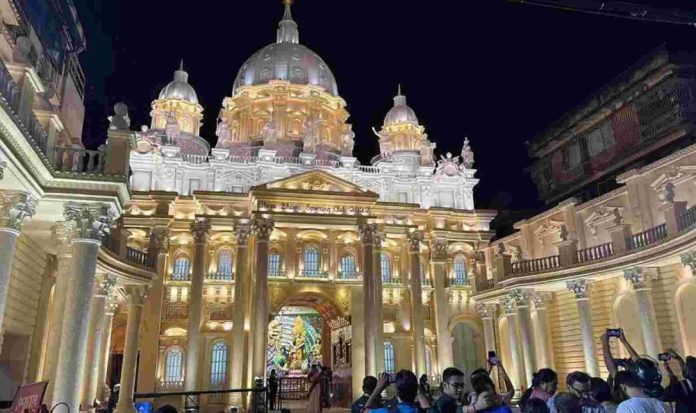By Chanakya
This is the time of year when a visit to West Bengal and , especially, its capital Kolkata, becomes completely magical. The city becomes a place from fairytales, of a place where dreams come true. This is the time of Durga Puja, the biggest festival in the state, celebrated on a scale unmatched by any festival anywhere in the country and, possibly in only a few celebrations around the world.
It is not just the time when the people celebrate togetherness and the incessant joys of life with friends, family and even people they do not know. It is also a time for travel, for reviving old friendships and relationships, of great food and, for some, for just being happily lazy.
This year it is a bit special with UNESCO’s Intergovernmental Committee for the Safeguarding of the Intangible Cultural Heritage having inscribed ‘Durga Puja in Kolkata’ on the Representative List of the Intangible Cultural Heritage of Humanity. This is great news for the city.
Be warned, that if you are wanting to visit the city at this time, the fun fiesta apart, it will be difficult to find a place to stay. So book early. Kolkata is connected to all places in India and most places across the globe. That is one reason why a host of tourists reach Kolkata, to take in a very special time of their lives.
The cultural capital of India
Located in eastern India along the Hoogly river, Kolkata is often referred to as the cultural capital of India. With the grand colonial architecture, rich traditions, beautiful music, art and food, this city has a unique character. As a home to esteemed personalities, such as poet Laureate Rabindranath Tagore and Satyajit Ray, among others, the people of this city have a special appreciation for literature as well as cinema. The city also provides an unparalleled religious and cultural experience of Durga puja each year.
“Dugga Dugga” echo the united voices of all the ladies in the household as they move towards the pandals for pujo, wishing for a safe journey ahead in life. The sound of intense beats coming from the dhak (local, traditional drums) mixed with the aroma of the dhunuchi (incense-burner used during arati of idol) lit in every house, park or corner fills the streets of Kolkata.
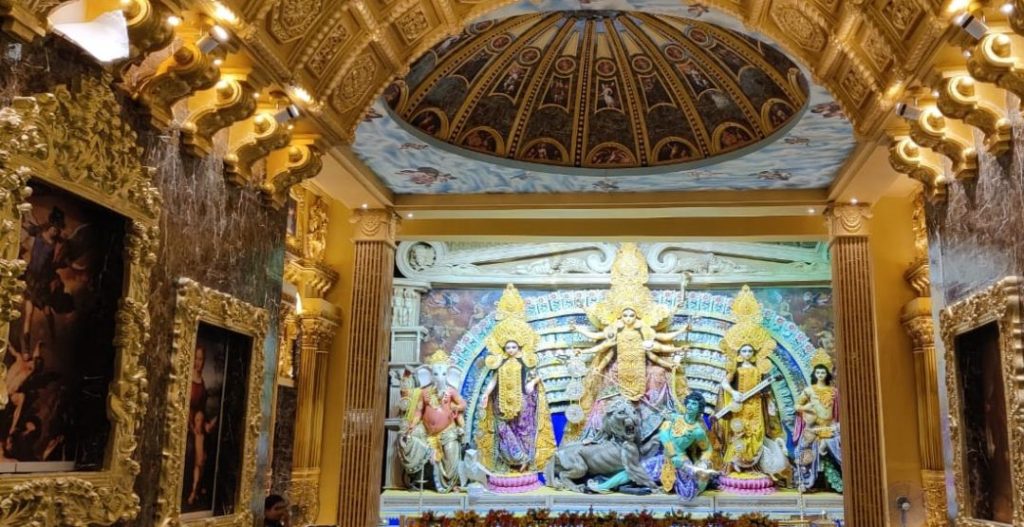

Clad in the most beautiful attire, adorning the heaviest of jewels and thickest of bangles with sindoor and bindis on their temples, the women seem to walk a step ahead of the men today. After all, Durga pujo is the day the evil perished. Nothing but colour and festivity flow through the lanes in the five to seven days that Maa Durga stays in her basha (house) with her four children, only to be united with her husband Shiva on the tenth day, (also known as Vijaya Dashami).
The legend of Durga
The legends speak of Goddess Durga as a creation of the three most powerful Devas (gods) in the Hindu Pantheon – Brahma (the creator), Vishnu (the preserver) and Shiva (the destroyer). The story of Durga’s birth is narrated in the Devi Bhagavatam.
According to this sacred text, once a son called Mahishasura was born to an Asura (demon). Born as an Asura, he saw the victory of Devas over Asuras in every fight. Annoyed by the constant defeat of the Asuras, Mahishasura decided to perform a tapasaya (a long penance) to please the Devas. Years went by. Impressed by Mahishasura’s dedication, Lord Brahma decided to grant him a boon.
Elated at such an opportunity, Mahishasura asked Brahma to bless him such that neither any man nor any God could kill him. Thus, his death would lie only in the hands of a woman – which in his mind was impossible.
Taking advantage of the boon, Mahishasura, along with his troop of Asuras, invaded the Earth. He looted and killed with impunity. Soon, raging with power, he decided to take over heaven believing he could be the ruler of all the three realms.
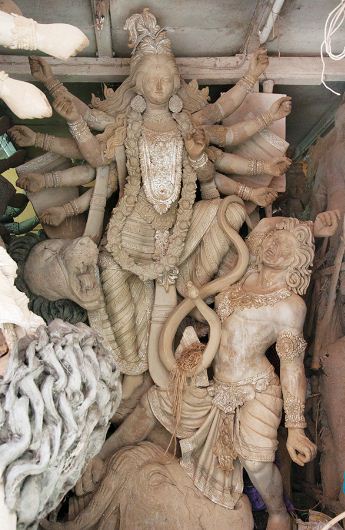

The battle between the Asuras and the Devas was ferocious. Mashishasura finally defeated the army of Indra in Amravati. Humiliated, the Devas met with the Tridevas, hoping to find a solution.
Frustrated and angry at the defeat of the Devas, the Tridevas started to think. “Only a woman can kill Mahishasura” said Lord Brahma, thinking about the boon he had given the Asura. But which woman in the three realms was strong enough to take on the battle? The Tridevas put their minds together and using their powers created energy that took the form of Devi Durga.
Each of the Devas gave their weapon to the Devi to help her kill Mahishasura. Himavat, the God of Himalaya, gave the Devi a Lion to mount on.
Initially, when Durga approached Amravati, Mahishasura laughed at the thought of fighting a woman. But as the war raged, Mahishasura realised that he was no match for the supreme powers embodied within the Devi. In the ten days of battle, the Asura kept changing forms to confuse her, but the Devi never missed her aim. As soon as the Asura changed to his original form, a buffalo, Durga swiftly beheaded him, thus freeing heaven and earth of the tyrant.
Thereafter, Durga came to be known as Mahishasura Mardini (the destroyer of Mahishasura). This last scene is replicated in many of the idols of the Devi worshipped in the Durga puja. In some idols the stance of Maa Durga while killing the Asura is similar to that of Shiva during Tandava.
History of puja in Bengal
Celebrated in the month of Ashvin (September – October), Durga puja (fondly referred to as Pujo) is one of the most awaited festivals in India, especially in West Bengal. Even though the weather starts becoming cooler, the air is thick with the warmth radiated by the devotees.
The origins of the Devi as a deity are lost in the mists of time. Over time, we find mentions of the Goddess in various texts from the Vedic era and also in the Ramayana and Mahabharata. Even much later, Krittivas’ rendition of Ramayana, composed in the 15th century, speaks of Durga being worshipped with 108 blue lotuses and 108 sacred lamps by Lord Rama before his battle with Ravana. The day that Lord Rama defeated Ravana is celebrated as Dussehra which falls on the tenth day (Dashami) of the Durga puja.
In literature from around the 16th century we find the first mentions of the grand celebration of Durga puja by zamindars (landlords) in West Bengal. Different scripts point to different rajas (kings) and zamindars who celebrated and financed the Durga puja for the whole village.
The boinedi barir pujo (Puja in the house of zamindars and people of stature in society) still remains a custom in Bengal. The bigger households place the idol in their courtyards of their houses – in the puja courtyard, known as thakur dalan – for people to come and pray.
Puja at Belur Math
One of the most famous institutions that celebrates Durga Puja is Belur Math, situated just across the Hooghly. The headquarters of Ramakrishna Math and Mission, Belur Math was founded by Swami Vivekananda. Established on the western bank of the Hoogly river, this Math hosts a very popular Durga puja.
The first Durga puja here was held in 1901 by Swami Vivekananda himself. Initially celebrated inside a small pandal, the Durga puja at Belur Math now attracts thousands of people every year.
Durga Puja Dates in 2022
DATE FESTIVAL
October 1 (Saturday) Maha Shashthi
October 2 (Sunday) Maha Saptami
October 3 (Monday) Maha Ashtami
October 4 (Tuesday) Maha Navami
October 5 (Wednesday) Bijoya Dashami/Dussehra
Durga Puja on UNESCO Representative List
UNESCO’s Intergovernmental Committee for the Safeguarding of the Intangible Cultural Heritage inscribed ‘Durga Puja in Kolkata’ on the Representative List of the Intangible Cultural Heritage of Humanity.
As a ten-day celebration, Durga Puja represents the collective worship of the Hindu Goddess Durga. During this time, masterfully designed clay models of the Goddess are worshipped in “pandals” or pavilions where communities get together and celebrate. Several folk music, culinary, craft, and performing arts traditions add to the dynamism of this celebration.


“I would like to offer warm congratulations to India, its people and especially all those who worked on the nomination dossier. I am confident that this inscription will offer encouragement to the local communities that celebrate Durga Puja, including all the traditional craftspeople, designers, artists, and organizers of large-scale cultural events, as well as tourists and visitors who partake in the inclusive festivity that is Durga Puja,” Eric Falt, Director of UNESCO, New Delhi, has been quoted as stating.
The 2003 UNESCO Convention for the Safeguarding of the Intangible Cultural Heritage promotes the protection of knowledge and skills necessary for traditional artisanship and cultural practices transmitted from generation to generation, such as oral traditions, performing arts, social practices, rituals and festive events, and knowledge and practices concerning nature and the universe.
Symbols and their meanings
Goddess Durga is known to be the most powerful deity as she has been bestowed with united powers of many Gods to eliminate all the demons on earth. The ten arms of the Goddess signify the protection of her devotees from all directions, which are the eight corners and from the sky and the earth. In fact, the great powers of the goddess are depicted with her ten hands holding different weapons of various significance.
Trishul (Trident)
The Trishul, which is gifted by Lord Shiva, has three sharp edges that symbolise the three qualities – Tanmas (serenity, inactivity and lethargic tendency), satva (salvation, positivity and purity) and rajas (peace, hyperactivity and desires). The balance of all three qualities must be perfect in order to attain peace and salvation. When the trident pierces the demons to death, the compassion of Mother Durga will perceive all the qualities to defeat and emerge as victorious.
Conch
The sound of the conch shell symbolizes the purest and sacred sound called ‘Om’ from which the entire creation of the universe emerged. It was gifted by Lord Varuna.
Sudarshan Chakra or discus
The Chakra is a gift from Lord Vishnu which symbolises that the world is controlled by Durga, who is the centre of the creation and the universe revolves around her. It also symbolises righteousness or dharma as it spins on the index finger of the goddess. This weapon is used to destroy all evil and protect the righteous ones.
Lotus
The lotus is the symbol of Lord Brahma which represents wisdom. The half bloom lotus also symbolises the awakening of spiritual consciousness in the minds even in the darkest times as also the lotus grows in the mud.
Bow and arrow
The bow and arrow are gifted by Lord Vayu and Lord Surya which symbolise energies. The bow represents potential energy whereas the arrow stands for kinetic energy. It also symbolises that Goddess Durga is the one that controls all the sources of energy in the universe.
Thunderbolt
Lord Indra’s gift symbolises firmness of spirit, determination, and supreme power. Goddess Durga empowers her devotee with unshaken confidence and will.
Sword
The Sword gifted by Lord Ganesh symbolises knowledge and intellect. It represents the sharpness of intellect and the shining power of the sword represents knowledge.
Spear
The spear symbolizes auspiciousness which is gifted by Lord Agni. It also represents pure, fiery power. This symbolises the quality possessed to know the difference between what is wrong and what is right and to act accordingly.
Axe
Goddess Durga received an axe and an armour from Lord Vishwakarma which signifies no fear of consequences when fighting evil.
Snake
The snake of Lord Shiva symbolises consciousness and masculine energy. It also represents the change from the lower state of consciousness to the higher state with an urge to experience new things.
Famous Durga Puja Pandals in India:
In Kolkata
Bagbazar
The Bagbazar Durga puja is one of the oldest pujas in Kolkata that is more than a century old. The Bagbazar Durga puja remains crowded all through the days of puja and is even more famous for the Durga idol. Apart from the striking idols and pandals, the carnival rides and stalls on the ground add more fun to the place.
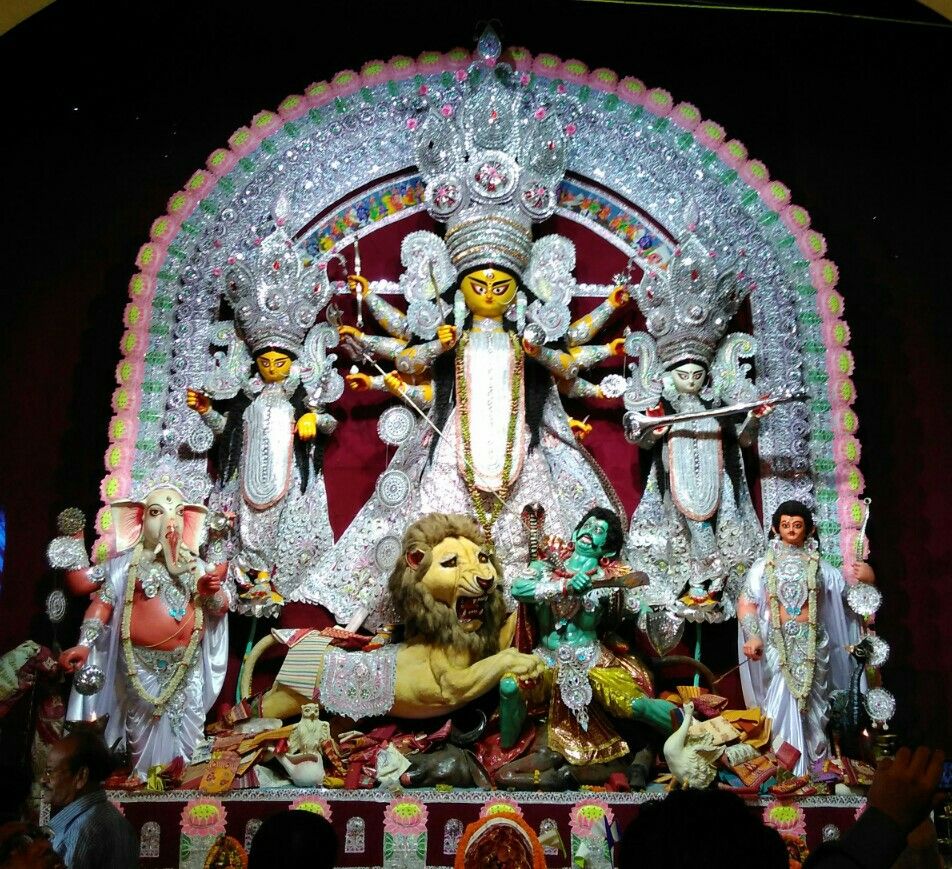

On the last day of Durga puja, which is Dashami, married women perform a very special ritual, Sindoor Khela. People from across the city visit the pandal on this specific day to witness the ritual.
How to reach: Near the Bagbazar Launch Ghat and Bagbazar Kolkata Circular Railway Station. The Metro railway station nearby is Shyambazar.
Santosh Mitra Square Durga Puja Pandal
Hosting Durga Puja for more than 80 years, Santosh Mitra Square is definitely a popular name when it comes to the best Durga Puja pandals in Kolkata.
If you remember, in 2017 this pandal became extremely popular by choosing the London Theme. In which Goddess Durga was seen in a Buckingham Palace like setting.
This year too, the committee has decided to do something that can pull a huge crowd despite the darkness spread by Covid 19. Durga idol artist Mintu Pal confirmed that this year the idol of Durga is going to be traditional. Due to the pandemic, they are not experimenting so much but the festive mood and enthusiasm will be the same as before.
In Mumbai
The celebration of this festival in Mumbai started by Bengalis who stayed in Mumbai. Since the Bengalis could not get to their home for a nine-day celebration, they started their own celebration in the foreign land. Soon, Mumbai became one of the top places to celebrate Durga Pooja.
Lokhandwala Durgotsav: Lokhandwala puja was first started by the local Bengali families around the locality in 1996. The primary aim of establishing this puja was to keep their Bengali traditions alive. Nowadays, Lokhandwala Durga Puja’s main leader is Abhijeet Bhattacharya. Hence, local people called this puja ‘Abhijeet Durga puja.’
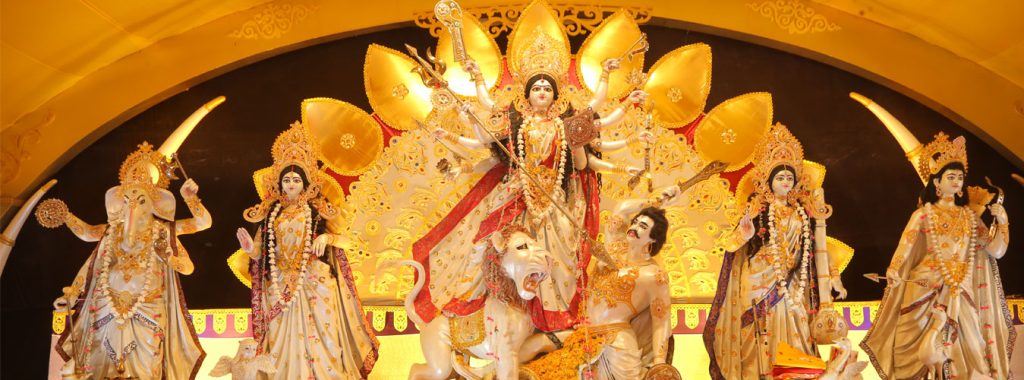

DURGA PUJA BEYOND BOUNDARIES
There is a common saying that when three Bengalis are assembled, a Durga Puja will not be far behind. The festival has crossed the oceans to all those continents wherever we Indians have made our presence felt. With the gaining popularity, the festival is being celebrated at more than 150 places across 36 countries beside India and Bangladesh, in all five continents. In America, Europe and Africa, Durga Puja was initiated nearly half a century ago.
The USA
Durga Puja is not an unknown festivity in the US where there is a good number of Indians especially Bengalis. The trend of organizing the five-day festival began in the early 1970s and by now, puja is celebrated in all 50 states of the country. There are several associations across the country that organize a five-day festival with full dedication and energy. Enjoy Durga Puja Celebrations in the United States!
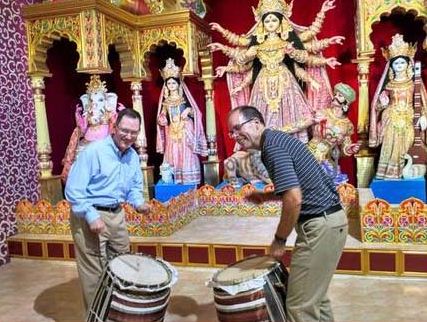

United Kingdom
Nearly half of the puja of the UK is conducted in London where several organizers import Goddess Durga idols and offer puja in the most authentic Bengali manner. The associations also conduct activities for all age groups in order to keep them engaged and busy. Recently, the immersion of the Durga idol has been permitted in the Thames river for the celebration held in London.
Australia
Durga Puja was initiated in the early 70’s by 12 families in New South Wales but currently the festival is celebrated in all the major cities of Australia. Thousands of Indian immigrants gather to render a warm welcome to Goddess Durga wherein the clay idols of the Goddess and her divine family are sculpted & painted and established inside the colorful sites. Celebrate Durga Puja 2022 in Australia.
Asia
In Nepal, Durga Puja also called ‘Dashain’ is celebrated as a ten day festival. Predominantly being a Hindu nation, the country observes the same date as India and follows the similar pattern for the celebration. Bangladesh, the home for the second-largest group of Hindu Bengalis worldwide celebrates Durga Puja in the most flourishing manner. Enjoy Digital Durga Puja 2022.
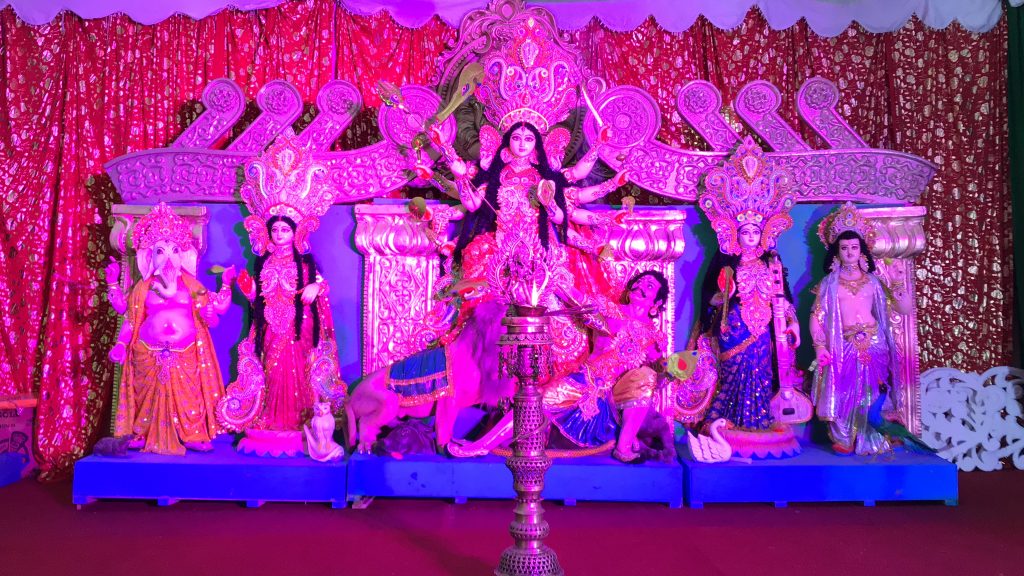

The importance of Pitri Paksh and Devi Paksh
Pitri Paksh
Pitru (or Pitri) Paksha, also known as Shradh, is a lot more than just not eating non-veg, no shopping, no celebrations. This is a paksh kaal (a fortnight, between two stages of the moon), mostly though a 16-day period, of prayers and homage to our ancestors who have departed from this materialistic world. The period is marked by offering prayers, food, and daan to the needy and the priests in the temple.
As per ancient folklore, when Karna, Kunti’s first son from Mahabharata died, he went to heaven and was offered gold and precious jewels, to which Karna asked Indra that he wish to have food and water, and not these precious jewels. Hearing that Indra replied to Karna that he only donated gold and jewels to people all his life and never offered food and water in the name of his ancestors.
To this, Karna told Indra that he didn’t know about his ancestors because he was blessed by Surya deva, the lord of light and day, to his mother, and he has no clue of his ancestors. After this Karna was sent to earth for a period of 15 days so that he could perform shradh for his ancestors and donate food and water. Since then, this period of 15 days is regarded as pitru paksha.
As documented in the Garuda Purana Shradh holds major significance in the first year of death. As per the ancient scriptures, it is believed that the soul starts travelling to Yamapuri on the 14th day after death and reaches there in 17 days. They again travel for 11 months to reach the court of Yamaraj. It is said that till the time the soul reaches the court, it has no access to food, water, and clothes. The daan, tarpan, and offerings that we perform during Pitru paksha reach these souls and satisfy their hunger and thirst.
